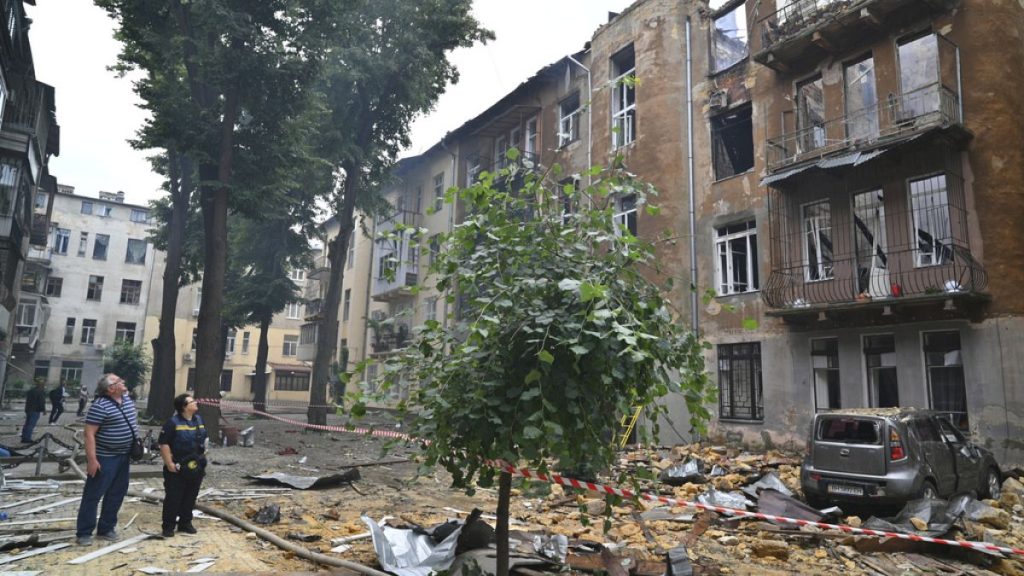In a troubling escalation of hostilities, Russia launched a significant aerial assault on Ukraine over the weekend, deploying an alarming 280 drones and missiles. The Ukrainian Armed Forces reported that they successfully neutralized approximately 260 of these threats. The primary target of the offensive appears to be the city of Kremenchuk, located in the Poltava region, where damage to civilian infrastructure has been reported, including injuries to residents. Eyewitness accounts reveal a community shaken by the violence, with local officials racing to respond to the aftermath.
| Article Subheadings |
|---|
| 1) Overview of the Attack |
| 2) Kremenchuk: The Target |
| 3) Impact on Civilians |
| 4) Response Efforts |
| 5) Broader Context of the Conflict |
Overview of the Attack
The Russian military executed a substantial operation on the night of June 21, 2025, unleashing a coordinated wave of aerial attacks involving 280 drones and missiles targeted at various points in Ukraine. Ukrainian officials reported that air defense systems successfully intercepted the majority of incoming threats, intercepting 260 units before they could cause widespread destruction. This recent military action marks a continued pattern of aggression amidst ongoing conflict, with both sides depicting their military capabilities as they engage in a tug-of-war for territorial dominance.
Kremenchuk: The Target
Kremenchuk, a city situated in the Poltava region of Ukraine, emerged as the focal point of the latest assault. During the attack, structures integral to the province’s energy infrastructure sustained direct hits, leading to extensive damages in residential areas. Officials like Volodymyr Kohut, the acting head of the Poltava regional military administration, confirmed that multiple homes and apartment buildings were affected, resulting in shattered windows and destroyed frames. Kohut highlighted that although air defenses managed to thwart a significant number of incoming strikes, some projectiles still penetrated their defenses and caused real harm to the civilian population.
Impact on Civilians
The aerial assault had immediate repercussions for the residents of Kremenchuk, exemplified by the account of local witness and victim Iryna Nosova, who described her experience during the attack. “Last night we had a nightmare; we have never seen anything like it,” she stated. Nosova’s narrative underscores the fear and trauma inflicted upon innocent civilians subjected to night-time warfare. Her statements resonate deeply within the community, as many shared her terror and confusion regarding the motives behind the strikes. The assault left visible scars on the city, with debris scattered across the streets and numerous properties damaged, forcing families to confront the physical and emotional aftermath of such violence.
Response Efforts
In the wake of the aerial attack, local response teams were swiftly mobilized to mitigate the damage. Rescue operations are in full swing, as emergency services work tirelessly to restore security and assess the extent of the destruction inflicted upon the city. Fortunately, only one reported injury stemmed from the airstrikes in Kremenchuk, though other regions, including Kherson, reported similar assaults that left civilians wounded. Local officials emphasized the need for ongoing vigilance, offering reassurances that the community remains resilient in the face of adversity. As crews conduct damage assessments, their focus extends beyond physical repairs; it also includes mentally supporting those who have suffered loss during this tumultuous time.
Broader Context of the Conflict
The attack on Kremenchuk does not occur in isolation; it reflects the larger, ongoing conflict between Russia and Ukraine, fraught with escalating tensions and military confrontations. In previous days, both nations have claimed targeted strikes against each other’s military assets, underscoring a military strategy increasingly characterized by direct assaults on critical infrastructure. The enduring cycle of violence raises questions about the potential for future diplomatic resolutions amid continual military engagements, leaving communities on both sides bracing for what lies ahead. The current geopolitical landscape suggests that the conflict is not nearing an end, propelling local populations into an uncertain future as they navigate life under constant threat from aerial assaults.
| No. | Key Points |
|---|---|
| 1 | Overnight, Russia launched a large-scale aerial attack on Ukraine, deploying 280 drones and missiles. |
| 2 | The city of Kremenchuk in the Poltava region was the primary target of this assault. |
| 3 | Local officials reported injuries to civilians and damage to residential homes and infrastructure. |
| 4 | Rescue operations are being conducted to address the aftermath of the attack and assist affected residents. |
| 5 | The incident reflects the broader, ongoing conflict between Russia and Ukraine, characterized by military escalations. |
Summary
The recent attack on Kremenchuk illustrates the ongoing turmoil in the region and the potential vulnerability of civilian life amid escalating military confrontations. As both sides remain entrenched in a prolonged conflict, the need for humanitarian assistance and solutions becomes increasingly urgent. With communities struggling to cope with the ramifications of these aerial assaults, the broader implications for peace and stability in the region continue to hang in a precarious balance.
Frequently Asked Questions
Question: What caused the recent aerial attack on Ukraine?
The recent attack is attributed to Russia’s ongoing military operations against Ukraine, targeting key infrastructure as a component of their broader military strategy.
Question: What damages were reported as a result of the Kremenchuk attack?
In Kremenchuk, damages included impacted energy infrastructure, shattered windows in residential buildings, and several vehicles being damaged due to debris from the strikes.
Question: How did Ukrainian forces respond to the aerial attack?
Ukrainian air defense systems effectively neutralized approximately 260 of the 280 drones and missiles that were launched during the attack, showcasing their capabilities in defensive operations.


